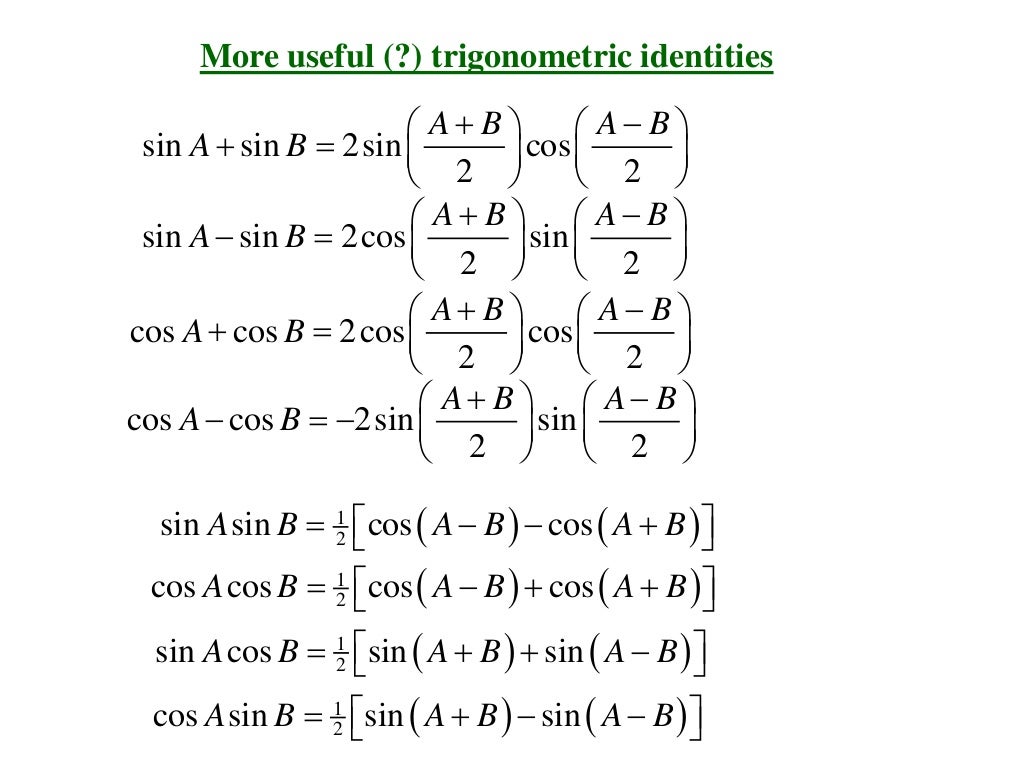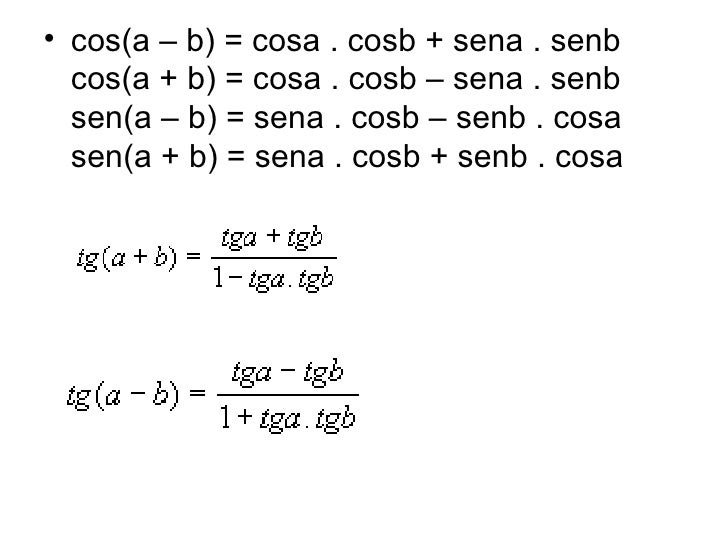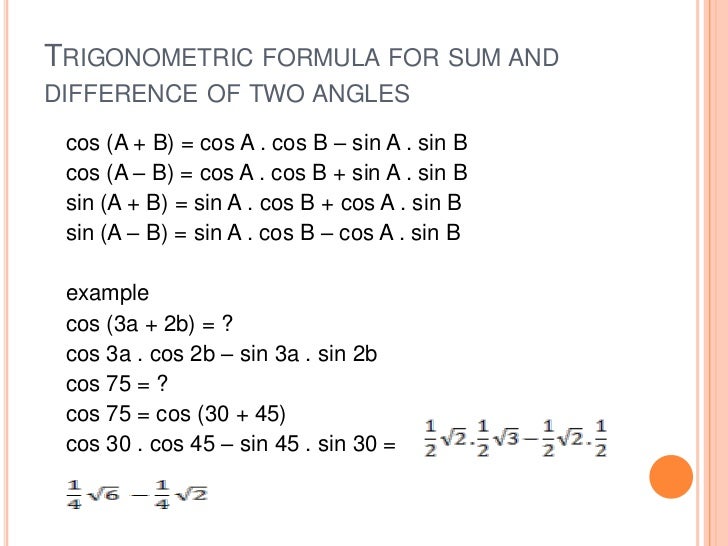
Useful trigonometric identities
Get Started Cos (a + b) In trigonometry, cos (a + b) is one of the important trigonometric identities involving compound angle. It is one of the trigonometry formulas and is used to find the value of the cosine trigonometric function for the sum of angles. cos (a + b) is equal to cos a cos b - sin a sin b.

Cos (a b) Formula, Proof, Examples What is Cos(a b)?
The formula of cos (A + B) is cos A cos B - sin A sin B. Example : If sin A = 3 5 and cos B = 9 41, find the value of cos (A + B). Solution : We have, sin A = 3 5 and cos B = 9 41 ∴ cos A = 1 - s i n 2 A and sin B = 1 - c o s 2 B cos A = 1 - 9 25 = 4 5 and sin B = 1 - 81 1681 = 40 41 Now, By using above formula,

Trigonometry
19 I know that there is a trig identity for cos ( a + b) and an identity for cos ( 2 a), but is there an identity for cos ( a b)? cos ( a + b) = cos a cos b − sin a sin b cos ( 2 a) = cos 2 a − sin 2 a cos ( a b) =? trigonometry Share Cite asked May 8, 2014 at 22:36 TechMaster100 499 2 6 13 2

law of cosines Law of cosine (cosine law)
The trigonometric identity Cos A - Cos B is used to represent the difference of cosine of angles A and B, Cos A - Cos B in the product form using the compound angles (A + B) and (A - B). We will study the Cos A - Cos B formula in detail in the following sections. Cos A - Cos B Difference to Product Formula

What is the Law of Cosines? (Explained in 3 Powerful Examples!)
Formula ( 1). cos ( a + b) = cos a cos b − sin a sin b ( 2). cos ( x + y) = cos x cos y − sin x sin y Introduction Let us consider that a and b are two variables, which denote two angles. The sum of two angles is written as a + b, which is actually a compound angle.

Cos A B Formula TRANSFORMACIONES TRIGONOMÉTRICAS DE SUMA A PRODUCTO Y DE Formulas for
The formula of cos (a+b)cos (a-b) is given by cos (a+b)cos (a-b) = cos 2 a -sin 2 b. In this post, we will establish the formula of cos (a+b) cos (a-b). Note that cos (a+b) cos (a-b) is a product of two cosine functions. We will use the following two formulas: cos (a+b) = cos a cos b - sin a sin b. (i) cos (a-b) = cos a cos b + sin a sin b. (ii)
The Cosine Rule IGCSE at Mathematics Realm
In this explainer, we will learn how to use Euler's formula to prove trigonometric identities like cos(A+B)= cosA.cosB- sinA.sinBand sin(A+B)= sinA.cosB+ sin.

Cos A B Formula TRANSFORMACIONES TRIGONOMÉTRICAS DE SUMA A PRODUCTO Y DE Formulas for
The Law of Cosines (also called the Cosine Rule) says: c 2 = a 2 + b 2 − 2ab cos (C) It helps us solve some triangles. Let's see how to use it. Example: How long is side "c". ? We know angle C = 37º, and sides a = 8 and b = 11 The Law of Cosines says: c2 = a2 + b2 − 2ab cos (C) Put in the values we know: c2 = 82 + 112 − 2 × 8 × 11 × cos (37º)

Law of Cosine (Cosine Law) with Examples and Proof Teachoo
Trigonometric Identities Purplemath What is an identity? In mathematics, an "identity" is an equation which is always true, regardless of the specific value of a given variable. An identity can be "trivially" true, such as the equation x = x or an identity can be usefully true, such as the Pythagorean Theorem's a2 + b2 = c2 MathHelp.com

IDENTIDADES TRIGONOMÉTRICAS PARA LA SUMA Y RESTA DE ÁNGULOS
cos^2(a + b) = cos^2(a) + cos^2(b) - 2cos(a)cos(b). Proof of Cos(a + b) Formula. The cos(a+b) formula is a mathematical expression used to determine the angle of two vectors. The formula is derived from the law of cosines, which states that the cosine of the angle between two vectors is equal to the product of their magnitudes and the sum of.

Trigonometry
Maths Math Formula Trigonometry Formulas Trigonometry Formulas In Trigonometry, different types of problems can be solved using trigonometry formulas. These problems may include trigonometric ratios (sin, cos, tan, sec, cosec and cot), Pythagorean identities, product identities, etc.

Cos (a + b) Formula, Proof, Examples What is Cos(a + b)?
Product to Sum Formulas sin x sin y = 1/2 [cos (x-y) − cos (x+y)] cos x cos y = 1/2 [cos (x-y) + cos (x+y)] sin x cos y = 1/2[sin(x+y) + sin(x−y)] cos x sin y = 1/2[sin(x+y) - sin(x−y)] Sum to Product Formulas sin x + sin y = 2 sin [ (x+y)/2] cos [ (x-y)/2] sin x - sin y = 2 cos [ (x+y)/2] sin [ (x-y)/2]

cos(A+B) YouTube
Step 1: Simplifying the expression. cos8x(1 + cos2x) c o s 8 x ( 1 + c o s 2 x) cos8x + cos8xcos2x c o s 8 x + c o s 8 x c o s 2 x. Now we still have two cos terms in multiplication, we can simplify it further by using the formula we just learned. Step 2: Applying the cos a cos b identity.

Trigonometric Addition and Difference Formulas (Identities) Also double angle formulas. hubpages
Because of all that we can say: sin (θ) = 1/csc (θ) cos (θ) = 1/sec (θ) tan (θ) = 1/cot (θ) And the other way around: csc (θ) = 1/sin (θ) sec (θ) = 1/cos (θ) cot (θ) = 1/tan (θ) And we also have: cot (θ) = cos (θ)/sin (θ) Pythagoras Theorem

Cos A Cos B Cos C Communauté MCMS
Cosines Tangents Cotangents Pythagorean theorem Calculus Trigonometric substitution Integrals ( inverse functions) Derivatives v t e In trigonometry, trigonometric identities are equalities that involve trigonometric functions and are true for every value of the occurring variables for which both sides of the equality are defined.

Law of Cosine (Cosine Law) with Examples and Proof Teachoo
Formula ( 1). cos ( a − b) = cos a cos b + sin a sin b ( 2). cos ( x − y) = cos x cos y + sin x sin y Introduction Let a and b be two variables, which are used to represent two angles in this case. The subtraction of angle b from angle a is the difference between them, and it is written as a − b, which is a compound angle.